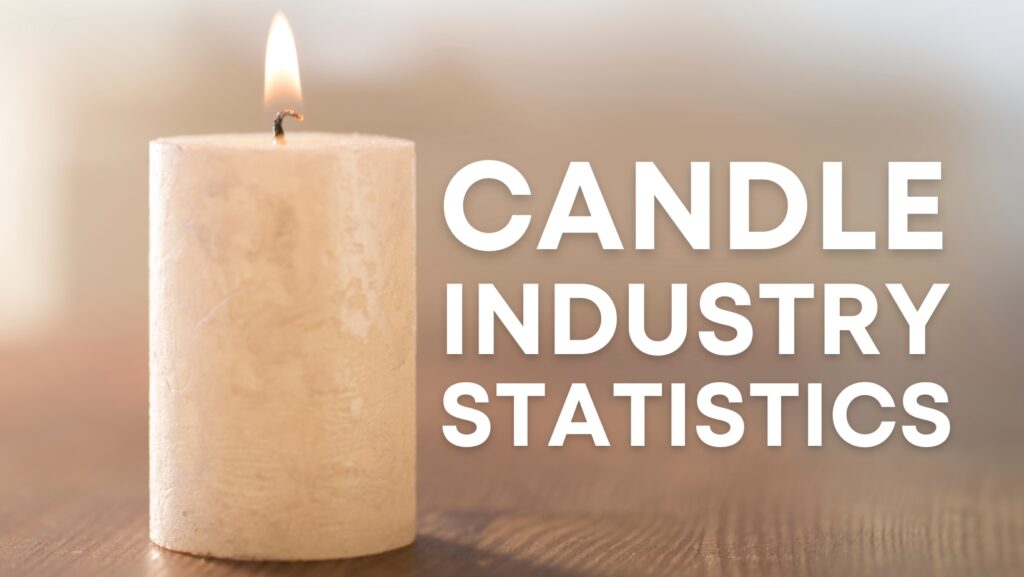This is by far the biggest research on the candle industry ever conducted. With more than 2 million data points, the Research Center have been able to estimate the most accurate market size of the candle industry to date. This article presents the main findings from the candle industry analysis.
Please reach out to researchcenter@bedbible.com for access to the full dataset. Please reference any use of the dataset, or the findings presented in the below analysis.
Key statistics
- The candle industry has a market size of $11 billion globally
- The US candle industry is worth $4.7 billion (staggering 42.7% of the global market size).
- The market size of the candle industry grows on average +4% each year (CAGR).
- The market for candles is expected to reach $14 billion worldwide by 2030 ($6 billion in the US).
- Scented candles make up 34% of all candles sold annually ($3.6 billion worth of scented candles).
- 33% of candles are sold online.
- Covid-19 sparked an +17% increase of candles sold compared to previous years.
- 31% of all sold candles are container candles, with $3,286 Millions sold annually.
Market size
- The candle market is worth $11 Billion worldwide.
- The candle market on average grow +4% annually.
- The candle market is expected to reach $14 Billion by 2030.
- The US market share of the total candle market is $4.71 Billion.
- A staggering 42.7% of all candles worldwide are bought in the US.
- The US candle market is expected to reach $6 Billion by 2030.
- The total candle market has grown by +120% in the past 20 years.
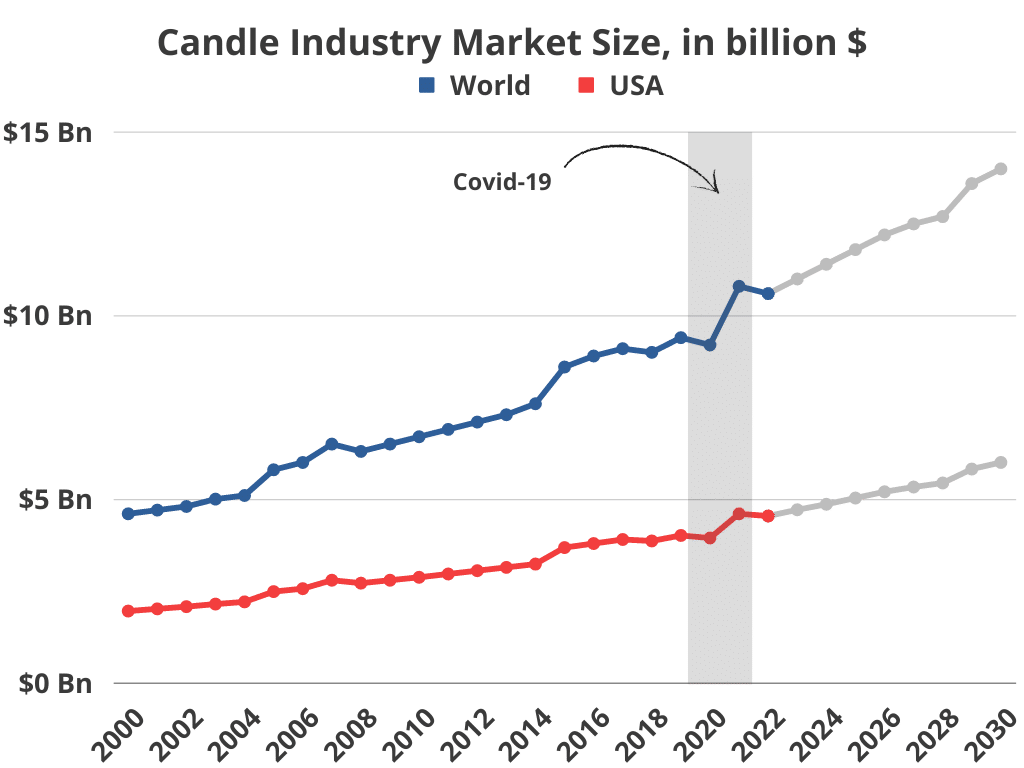
| Year | Total Candle Market Size, World | CAGR, YoY Growth | Market share, US |
|---|---|---|---|
| 2000 | $4.56 Billion | – | $1.95 Billion |
| 2001 | $4.70 Billion | +3% | $2.01 Billion |
| 2002 | $4.84 Billion | +3% | $2.07 Billion |
| 2003 | $4.98 Billion | +3% | $2.14 Billion |
| 2004 | $5.13 Billion | +3% | $2.20 Billion |
| 2005 | $5.80 Billion | +13% | $2.48 Billion |
| 2006 | $5.97 Billion | +3% | $2.56 Billion |
| 2007 | $6.51 Billion | +9% | $2.79 Billion |
| 2008 | $6.32 Billion | -3% | $2.71 Billion |
| 2009 | $6.51 Billion | +3% | $2.79 Billion |
| 2010 | $6.71 Billion | +3% | $2.87 Billion |
| 2011 | $6.91 Billion | +3% | $2.96 Billion |
| 2012 | $7.12 Billion | +3% | $3.05 Billion |
| 2013 | $7.33 Billion | +3% | $3.14 Billion |
| 2014 | $7.55 Billion | +3% | $3.23 Billion |
| 2015 | $8.59 Billion | +14% | $3.68 Billion |
| 2016 | $8.85 Billion | +3% | $3.79 Billion |
| 2017 | $9.11 Billion | +3% | $3.9 Billion |
| 2018 | $9.09 Billion | -1% | $3.86 Billion |
| 2019 | $9.35 Billion | 4% | $4.01 Billion |
| 2020 | $9.20 Billion | -2% | $3.94 Billion |
| 2021 | $10.75 Billion | +17% | $4.60 Billion |
| 2022 | $10.6 Billion | -1% | $4.54 Billion |
| 2023 | $11.02 Billion | +4% | $4.71 Billion |
| 2024 | $11.35 Billion | +3% | $4.86 Billion |
| 2025 | $11.75 Billion | +4% | $5.03 Billion |
| 2026 | $12.15 Billion | +3% | $5.20 Billion |
| 2027 | $12.45 Billion | +2% | $5.33 Billion |
| 2028 | $12.71 Billion | +2% | $5.44 Billion |
| 2029 | $13.59 Billion | +7% | $5.82 Billion |
| 2030 | $14.01 Billion | +3% | $6.00 Billion |
Candle wax
- Over one billion pounds of wax are used every year in the US candle industry to produce the candles sold.
- An estimated 3.7-4.5 billion pounds of candle wax are used globally.
The most common wax type used is paraffin, which is used in more than 92% of candles sold globally. Other popular candle wax types include:
- Soy wax
- Beeswax
- Palm wax
By type of candle
In the candle industry a few very broad categories exists. Ranked from most popular, with the largest market share of the total candle market, the different candle types are:
- Container candles, with a market share of 31% of the total candle market, with sales exceeding $3.2 Billions annually.
- Taper candles, with a market share of 24% of the total candle market, with sales exceeding $2.5 Billions annually.
- Pillar candles, with a market share of 31% of the total candle market, with sales exceeding $3.2 Billions annually.
- Votive candles, with a market share of 15% of the total candle market, with sales exceeding $1.5 Billions annually.
- Other types of candles include: Tea lights, jar candles, and tumbler vase candles. The remaining candle market is around 8% and is worth just shy of one billion USD.
Apart from that, some count scented candles as a “type of candle”. However, most different types can use both scented and unscented candle wax. Therefore, the following market share analysis between the different types of candles only focus on structural differences and the relative market share. This is done to avoid overlap between categories.
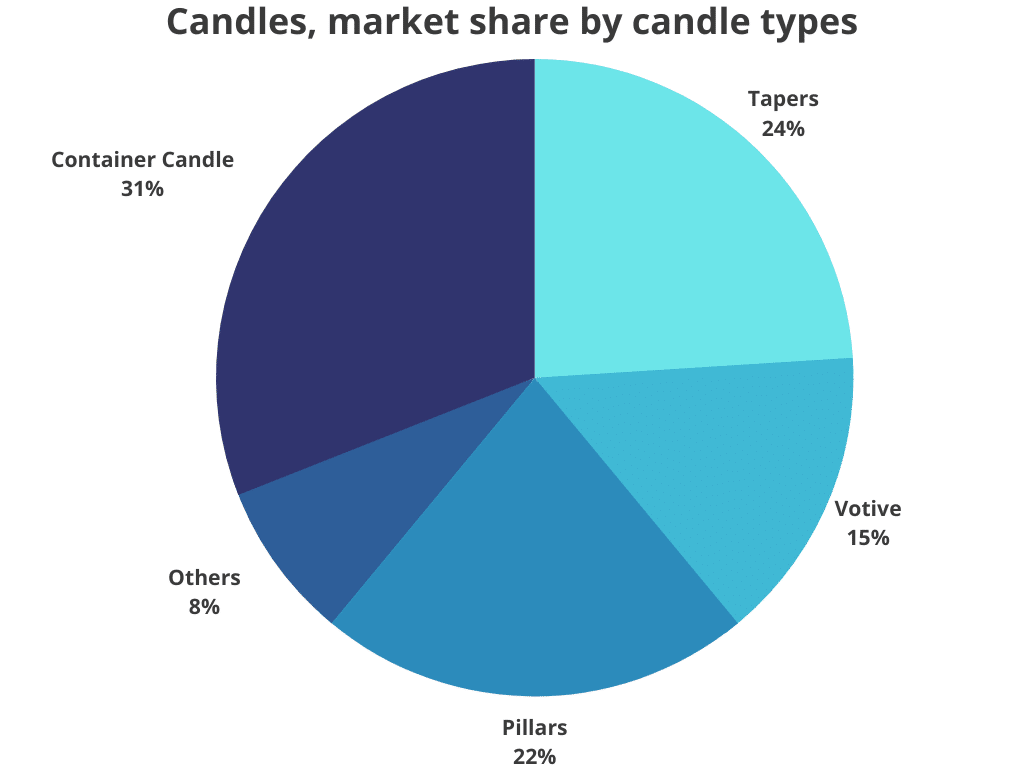
| Rank | Candle type | Market share | Millions sold, World | Millions sold, US |
|---|---|---|---|---|
| 1 | Container candles | 31% | $3,286 Millions | $1,408 Millions |
| 2 | Taper candles | 24% | $2,544 Millions | $1,090 Millions |
| 3 | Pillar candles | 22% | $2,332 Millions | $999 Millions |
| 4 | Votive candles | 15% | $1,590 Millions | $681 Millions |
| 5 | Others (e.g. tea lights) | 8% | $848 Millions | $363 Millions |
Scented candles vs. unscented
As part of the market share analysis of different types of candles, we also looked at how the sales of scented candles looked compared to classic candles.
- The scented candles market size is $3.6 Billion (a 34% market share of the total $10.6 Billion candle market).
- 34% of all candles sold are scented canldes, meaning they have some scent infused in the wax.
- The scented candle market is growing at +4.1% annually (CAGR) – slightly faster than the overall market.
Where are candles sold
Generally candles are sold in a wide varaity of stores, such as:
- Speciality or gift shops.
- Department and home decor stores.
- Mass merchandisers (discount stores, drug store chains, grocery stores, etc.).
Online vs. offline
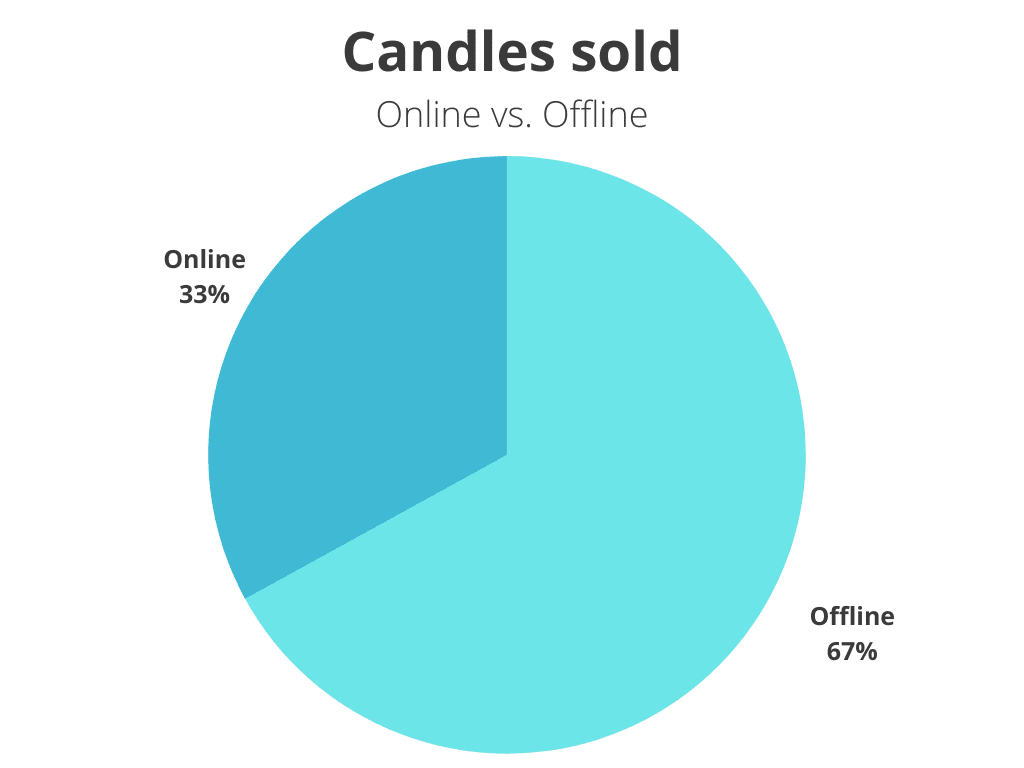
- 33% of candles are sold in online stores (e.g. Amazon, and Online speciality stores).
- 67% of candles are sold in physical stores (e.g. Department stores, Grocery stores, and Gift shops).
Most popular fragrances in scented candles
The most common types of candles produced by companies are scented candles, with popular fragrances including vanilla, lavender, and citrus.
We also looked into what types of scented people preferred in the market.
Albeit, this was slightly harder as most manufacturers, distributors, and stores (online or offline) typically rename classic scents.
Additionally, a lot of scented candles mix different scents.
Overall, this makes it difficult to standardize a method of categorizing SKUs (different scented candles).
The below are our best estimates on the most popular scents and the relative proportion of candles in which they are used:
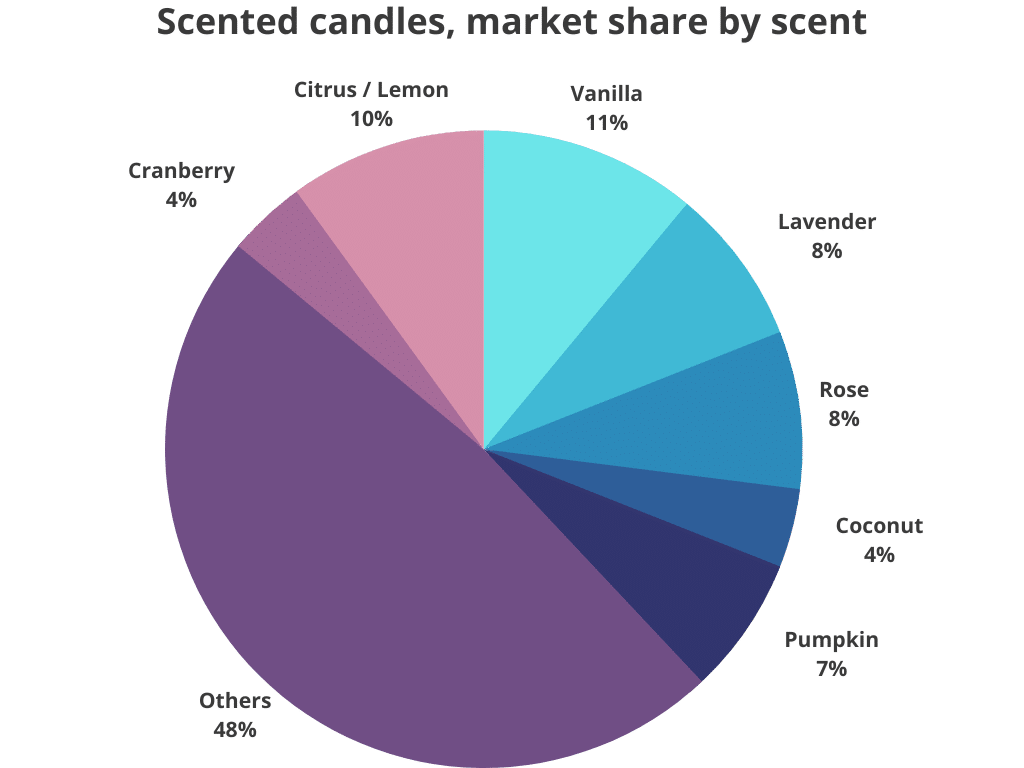
- 11% of all scented candles smell of vanilla.
- 10% of all scented candles smell of Citrus / Lemon.
- 8% of all scented candles smell of Lavender.
- 8% of all scented candles smell of Rose.
- 7% of all scented candles smell of Pumpkin.
- 4% of all scented candles smell of Coconut.
- 4% of all scented candles smell of Cranberry.
- 3% of all scented candles smell of Gardenia.
- 2% of all scented candles smell of Coffee.
- 2% of all scented candles smell of Amber.
- 2% of all scented candles smell of Sage.
- 2% of all scented candles smell of Cinnamon.
- 2% of all scented candles smell of Eucalyptus.
- 2% of all scented candles smell of Peppermint.
- 2% of all scented candles smell of Sandalwood.
- 2% of all scented candles smell of Chocolate.
- 1% of all scented candles smell of Fir.
- 1% of all scented candles smell of Cedar.
- <1% of all scented candles smell of Leather.
- <1% of all scented candles smell of Musk.
- <1% of all scented candles smell of Patchouli.
- <1% of all scented candles smell of Tobacco.
- <1% of all scented candles smell of Oud.
- <1% of all scented candles smell of Teakwood.
Apart from that around 24% of scented candles fell in “Others”. Typically because they A) were a mix with no dominating smell listed, making it uncategorizable in one category, B) were scented candles without specific listed natural scents, or C) were scented candles without any description of the scent type.
Biggest companies
The worlds single biggest candle producer is SC Johnson & Sons, who annually sell candles for $184 million.
The worlds second and third biggest producers are The Yankee Candle Company (with $132 million in annual sales), and Newell Brands (with $113 million).
Other big candle producers and sellers include:
- Bath & Body Works
- Better Homes and Garden
- Bridgewater Candles
- Colonial Candle
- Conscious Candle Company
- Contract Candles & Diffusers Ltd.
- Circle E Candles
- Diptyque
- Ellis Brooklyn
- Jo Malone London
- Le Labo
- Malin + Goetz
- NEST
- Slatkin & Co
- Thymes
- TRUDON
- Village Candles
- White Barn Candles
- Yankee Candles
Covid-19
The COVID-19 pandemic has led to increased demand for candles, as people spend more time at home and look for ways to create a cozy and relaxing atmosphere.
This can be seen in the +17% increase of the candle industry in the year following the outbreak of Covid-19. A significant increase unmatched by any other year in the industries history – and compared to the average annual growth of +4%.
Fact sheet
- Candles have been used for lighting for thousands of years, dating back to ancient times when they were made from tallow or beeswax.
- The word “candle” comes from the Latin word “candela,” which means “to shine.”
- Candles are made by melting wax and then pouring it into a mold with a wick in the center.
- Candles can be scented or unscented, with popular scents including vanilla, lavender, and cinnamon.
- Candles can also be used for religious and ceremonial purposes, such as in churches, temples, and during funerals.
- The color of a candle can symbolize different meanings, with white representing purity and innocence, red representing love and passion, and black representing death and mourning.
- Burning candles can create a relaxing atmosphere and promote a sense of well-being, with some people using them for aromatherapy.
- The wick of a candle is typically made of cotton or paper, and is designed to draw the melted wax up to fuel the flame.
- The size of the wick can affect the burning time and the brightness of the flame.
- Candles can be made with multiple wicks, which can provide a brighter flame and faster melting time.
- Candle making is a popular hobby and craft, with many people making their own candles at home using kits or DIY instructions.
- Candle wax can be dyed or colored with pigments to create different hues and shades.
- Some candles are marketed as “natural” or “organic,” but it is important to check the ingredients to ensure they are safe and environmentally friendly.
- The heat from a candle flame can cause the wax to melt and release fragrance oils into the air, creating a pleasant scent.
- Beeswax candles are popular because they burn cleanly and have a sweet, natural fragrance.
- Soy candles are often preferred by environmentally conscious consumers because soy wax is biodegradable and made from a renewable resource.
- Candles have been used as a source of light during power outages and emergencies, and can provide a comforting sense of warmth and security.
- The candle industry is regulated by various government agencies, such as the Consumer Product Safety Commission in the United States, which sets standards for candle safety and labeling.
Candle wax facts
- Candle wax is the primary material used to make candles.
- There are several types of candle wax, including paraffin wax, beeswax, soy wax, palm wax, and gel wax.
- Paraffin wax is the most commonly used wax for candles and is derived from petroleum.
- Beeswax is a natural wax produced by bees and is known for its sweet, honey-like scent.
- Soy wax is a vegetable-based wax made from soybean oil, and is often used as an alternative to paraffin wax.
- Palm wax is a natural wax derived from palm oil and is popular for its unique crystalline texture.
- Gel wax is a transparent wax that is often used to make decorative candles.
- The melting point of candle wax varies depending on the type of wax, with paraffin wax melting at around 130-150°F (54-65°C) and beeswax melting at around 144-147°F (62-64°C).
- The color of candle wax can be changed by adding dyes or pigments.
- The texture of candle wax can be changed by adding additives, such as stearic acid, which can make the wax harder and less likely to melt in warm temperatures.
- The quality of the wax can affect the burn time, fragrance throw, and appearance of the candle.
- The composition of candle wax can also impact its environmental impact and sustainability, with some types of wax being more eco-friendly than others.
- Candle wax can be recycled and repurposed into new candles or other products.
- The wax pool that forms around the wick as a candle burns is an important part of the burning process, as it releases fragrance oils and helps to fuel the flame.
- The amount of wax used in a candle can affect its burn time, with larger candles generally burning for longer than smaller ones.
Enhancing Intimate Moments with Candles and Toys
Candles have long been associated with creating a romantic and intimate ambiance. Their soft glow and soothing scents set the mood for relaxation and intimacy. But to elevate these moments even further, many individuals and couples are turning to sex toys. Here’s a closer look at some popular choices:
- Vibrators: From the classic vibrator to the innovative remote control vibrator and the dual-action rabbit vibrator, these toys offer a range of sensations.
- For Men: Explore pleasure with male masturbators, penis pumps, and cock rings.
- For Couples: Enhance shared moments with vibrating panties, best couples sex toys, and strap-ons.
- BDSM and Bondage: Dive into the world of BDSM with ball gags, handcuffs for sex, bdsm restraints, and bondage collars.
- Unique Sensations: Experience new thrills with sex machines, sex swings, thrusting dildos, and suction cup dildos.
- Reviews and Insights: For those new to the world of adult toys or sexual pleasure looking for honest advise, check out our OMGYes review and for some more naughty audio material check our our Dipsea review.
- Other Favorites: Explore other popular choices like butt plugs, bullet vibrators, female sex toys, and male sex toys.
In conclusion, combining the ambiance of candles with the pleasure of sex toys can create unforgettable intimate moments. Whether you’re exploring solo or with a partner, there’s a world of sensations waiting to be discovered.
